#Priam's Birdwing
Explore tagged Tumblr posts
Text

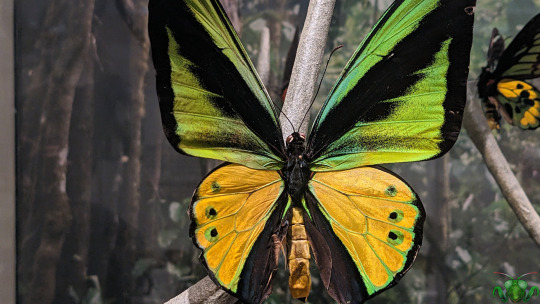
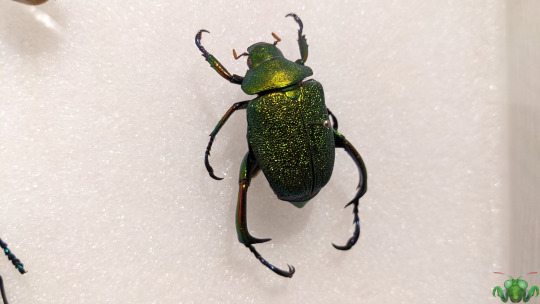


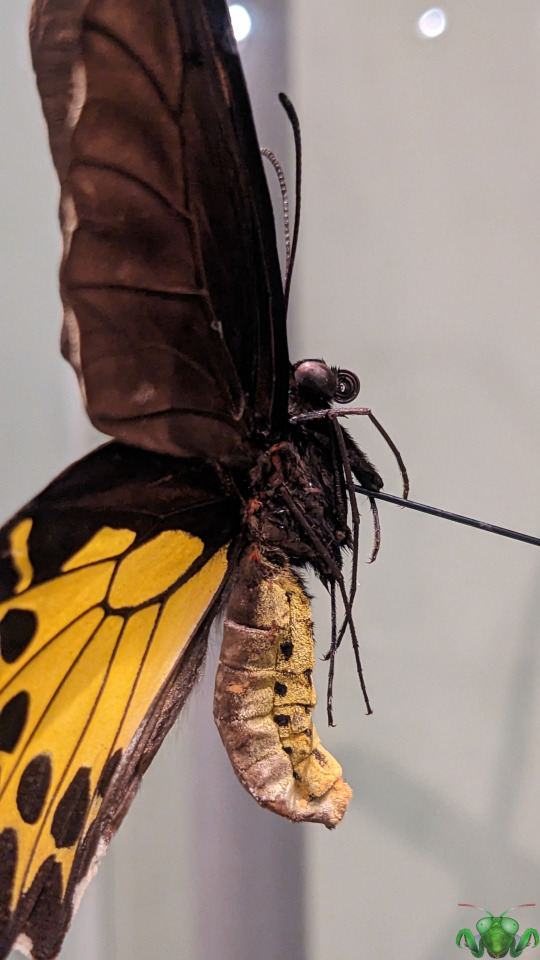
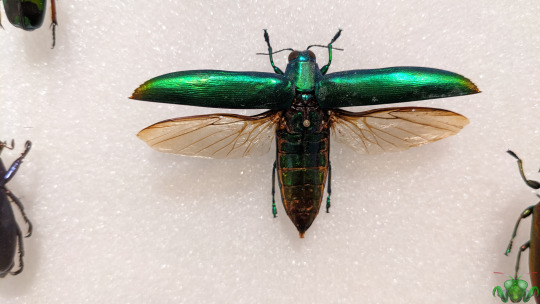



Royal Ontario Museum - Insect Exhibits 2
Good news, I managed to squeeze in one more insect visit to the Royal Ontario Museum before the end of the year! As such the living denizens of the natural history section will be showcased one more time before 2024 is upon us. Before that, I'd like to take a moment to share new pictures from the insect displays within the natural history section. Compared to the pictures from 2019, these are a quantum leap forward in terms of clarity and use of lighting. The Peanut Bug - Fulgora laternaria (Picture 1) has always been a favorite of mine, so I always take the opportunity to go and visit it and marvel at the ridiculousness of the size of that head protuberance. Though a bit oversized, such a head fixature has an important function: knocking it against a tree is its mating call. If the attention they draw is unwelcome, they can startle their voyeurs with the eyeball spots on its wings. These markings are more prominent in live specimens; this pinned specimen's colors have faded away over time. You can even compare the images from 2019 and you'll see a difference in color saturation. Otherwise, when this Hemipteran is at rest, it looks similar to a helmeted Cicada with more opaque wings. In terms of relations however, the Peanut Bug is more closely related to the Spotted Lanternfly of Asia, as they are both part of the family Fulgoridae.
I'm also particularly fond of the texture of the Shining Leaf Beetle's (Picture 3 - Chrysophora chrysochlora) ornate emerald shell, and the tropical colors of the Weevils on display. Especially the blue Eupholus specimens (Picture 9 - right side specimens). Finally, I also noticed a new section (to me) in the animal gallery featuring Butterflies of the tropics and I'm still amazed at how large they are. Many of these iridescent, vibrantly-colored specimens have wingspan sizes that can be as large as a hand! They are more appropriately known as Birdwing Butterflies and they are all giants compared to the Butterflies that grow in the temperate climate of Toronto! The specimens focused on here are the Green Goliath Birdwing (Ornithoptera goliath - Pictures 2, 5 and 6), the black-and-white female Priam's birdwing (Ornithoptera priamus - Picture 8), the male Palawan Birdwing (Trogonoptera trojana - Picture 10 top), Wallace's Golden Birdwing (Ornithoptera croesus - Picture 10 middle) and the female Paradise Birdwing (Ornithoptera paradisea - Picture 10 bottom), but there are many more in the background. To glimpse these in person is wonderful, but seeing them flying around in their tropical environments would be a magical experience!
Pictures were taken on December 19, 2023 with a Google Pixel 4. Please come and see the bugs if you can, both the living insect specimens and the many displays. You may go to this link and view a post from earlier: ROM - Insect Exhibits 1.
Since these insect collections belong to the ROM, I’ve marked them with the Mantis icon. As well, Happy first day of Winter (tomorrow)!

#jonny’s insect catalogue#insect#royal ontario museum#insect showcase#ROM insect#insect display#insect exhibit#pinned insects#lepidoptera#coleoptera#hemiptera#butterfly#birdwing butterfly#beetle#weevil#snout beetle#heteroptera#true bug#peanut bug#lanternfly#lantern fly#scarab beetle#first day of winter#toronto#december2023#2023#entomology#nature#invertebrates#arthropods
12 notes
·
View notes
Text
Ornithoptera genus




Ornithoptera tithonus - Tithonus birdwing (3)
Ornithoptera euphorion - Cairns birdwing (2)
Ornithoptera priamus - Priam's birdwing (1,4)
Family: Papilionidae
#ornithoptera#ornithoptera tithonus#ornithoptera euporion#ornithoptera priamus#papilionidae#Tithonus birdwing#Priam's birdwing#Cairns birdwing#butterflies and moths#butterflies#butterfly#lepidoptera#lepidopterist#lepidopterology#insects#insect#bugs#nature#pretty#animals
144 notes
·
View notes
Photo
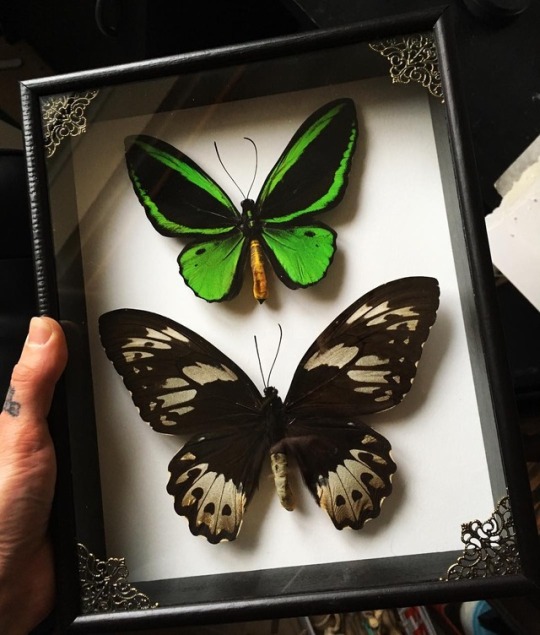
NFS- 😍 Ornithoptera priamus, the common green birdwing, (also known as Cape York birdwing, Priam's birdwing or northern birdwing) They’re a widespread species of birdwing butterfly. 🙏🏻✨🦋I also have the CITES documentation for them 🖤 #jennascuriocabinet #papilionidae #ornithoptera #ornithopterapriamus #birdwing #lepidoptera #entomology #entomologydisplay #curiodisplay #entomologyart #insectdisplay #insectslovers #butterfliesofinstagram #butterflys #butterflydecor #macabreart #butterflies #butterfliesofinstagram #wunderkammer #bigbutterfly #oddities #odditiesandcuriosities #picoftheday #oddity #staystrange #stayweird #cabinetofcuriosities #curiocabinet #artistsoninstagram #photooftheday (at Jenna's Curio Cabinet) https://www.instagram.com/p/BwEh0kjHizG/?utm_source=ig_tumblr_share&igshid=fml6vftkmat1
#jennascuriocabinet#papilionidae#ornithoptera#ornithopterapriamus#birdwing#lepidoptera#entomology#entomologydisplay#curiodisplay#entomologyart#insectdisplay#insectslovers#butterfliesofinstagram#butterflys#butterflydecor#macabreart#butterflies#wunderkammer#bigbutterfly#oddities#odditiesandcuriosities#picoftheday#oddity#staystrange#stayweird#cabinetofcuriosities#curiocabinet#artistsoninstagram#photooftheday
1 note
·
View note
Text

Decided to make a Pre-made of my Hooti lines, based on a Male Priam’s Birdwing, 32% edited.
Available here for 20USD: http://www.aywas.com/forum/topic/158470/
I might do more if people are interested.
2 notes
·
View notes
Photo

“Specimen 014 - Obi Island Birdwing (Ornithoptera aesacus), male”
2018
100 x 100mm
Acrylic, ink & 24ct gold leaf on canvas panel
This rare species of birdwing butterfly is endemic to the Island of Obira (formerly Obi), Indonesia. It inhabits tropical rainforest. Due to extensive logging on the island the conservation of the species is a concern, and has been classified as 'vulnerable' by the ICUN. Twenty years ago it was the rarest birdwing species in the world. It remains threatened, but is commercially bred, and since logging is no longer allowed on the island it is assumed that the butterfly numbers are fairly secure. The male O. aesacus has a brilliant turquoise-blue sheen. The real butterfly has a wingspan of 140-190mm. Hand finished with real 24ct gold leaf.
In Greek mythology, Aesacus was a son of King Priam of Troy and his first wife, Arisbe. When Aesacus' great love Asterope, the daughter of the river Cebren, died he tried repeatedly to kill himself by jumping into the sea from a high cliff. Eventually the Gods took pity on him and transformed him into a diving bird "thus allowing him to indulge his passion with greater decency".
Painted to a true likeness in acrylic with ink added over the paint using a calligraphy nib. These small framed paintings are a bright artistic take on real mounted taxidermy butterfly specimens, hinting at the beauty of the natural world.
#alexa#aulds#Alexa Aulds#alexaaulds#contemporary#contemporaryart#london#butterfly#nature#natural history#specimen#gold leaf#acrylic#painting#animals#animal art#female artists#Women Artists#ink#turquoise#blue
6 notes
·
View notes
Photo


Common green birdwing, Cape York birdwing, Priam's birdwing or northern birdwing (Ornithoptera priamus) a widespread species of birdwing butterfly found in the central and south Moluccas, New Guinea, Bismarck Archipelago, Solomon Islands, and north-east Australia.
102 notes
·
View notes
Text
Learn to embroider butterflies
http://amazing-handmade.tumblr.com
Author Zaya
All butterfly embroidered long straight Stozhkov; small details, such as spots, embroidered on the base layer of stitches. They help to secure the long stitches to make the embroidery more durable. Veins also help to secure the long stitches, perform them across the stitches of the base layer and not along them. The body of the butterfly is divided into parts and executed in satin stitch thread embroidery in one addition, all parts but the queue. Antennae are embroidered with silk, or any thin black thread - for example for machine embroidery. Tack the long straight stitches to fabric, finish barbel short stitch “back needle*. Priam's birdwing Ribbon: yellow, green, black width And mm black 2 mm in width. Thread: black (for the body and antennae). - Carefully draw the contours. Green ribbons follow the 3 long stitches along the front edge of the front fenders. - Pass the black tape and continue to fill the picture long straight stitches. Yellow ribbons embroider over black, make 2 stitch along the inside edge and 3 short stitch to the rear edge of both front wings. - Rear wings are embroidered with yellow ribbons above them made a few green stitches and 3 tiny black dots at the bottom edge. - Finish the front edge of the front wings, with a series of entwined basting stitches black ribbons along the edge of the green stitches. Pull the stitches tight to form a very thin line. Panel rear wings next stitch "Palestrina” black ribbon with a width of 2 mm. - Black thread stitching complete body satin stitch. - Embroider the antennae. Papilio Ulysses
Mite: red, black, white 2 mm in width. Thread: white (body) black (for the antennae, veins). - Trace over the contours indicate the blue crane field of the PA wings. - Complete the Nola blue long straight stitches. - Perform black border, overlapping the stitches at the edge of the blue field. - Finish the front edge of the front wings beside the thin entwined with basting stitches black ribbons. - Embroider black dot on a blue field closer to the front edge of the wing. Panel rear fenders stitch “Palestrina” black years. White ribbons embroider a tiny loop-like straight stitches on the outer edge of the wings, in place of the protrusions. - Body embroider satin stitch in brown thread. - Embroider black thread veins and tendrils. Apple butterfly
Ribbons: blue, pink, brown, white width 2 mm. Thread: Golden (body), black (for the antennae). - Carefully trace over the contours indicate the boundaries of the pink field. - Embroider the inner part of the wings pale pink ribbons. - The outer part of the wings embroider blue ribbons to the stitches together, but do not overlap each other. - Add in the blue foyer of the white drawing. - Embroider tiny deep pink spots on a blue background rear fenders. Panel edges pale pink parts of the wings of small straight stitches in a darker pink colors, moving from pink parts of the wings to the guineas. - Finish the trim on the front edge of the wings near the thin entwined with basting stitches brown ribbons. - Embroider the remaining part of the wings stitch “Palestrina”, do the loop-shaped straight stitches white ribbons along the outer edge of each prong. The other loop-like stitches are inside brown outline of the rear wings. - Complete body satin stitch gold thread for embroidery and embroider antennae.




0 notes
Text
Learn to embroider butterflies
http://fa-style.tumblr.com
Author Zaya
All butterfly embroidered long straight Stozhkov; small details, such as spots, embroidered on the base layer of stitches. They help to secure the long stitches to make the embroidery more durable. Veins also help to secure the long stitches, perform them across the stitches of the base layer and not along them. The body of the butterfly is divided into parts and executed in satin stitch thread embroidery in one addition, all parts but the queue. Antennae are embroidered with silk, or any thin black thread - for example for machine embroidery. Tack the long straight stitches to fabric, finish barbel short stitch “back needle*. Priam's birdwing Ribbon: yellow, green, black width And mm black 2 mm in width. Thread: black (for the body and antennae). - Carefully draw the contours. Green ribbons follow the 3 long stitches along the front edge of the front fenders. - Pass the black tape and continue to fill the picture long straight stitches. Yellow ribbons embroider over black, make 2 stitch along the inside edge and 3 short stitch to the rear edge of both front wings. - Rear wings are embroidered with yellow ribbons above them made a few green stitches and 3 tiny black dots at the bottom edge. - Finish the front edge of the front wings, with a series of entwined basting stitches black ribbons along the edge of the green stitches. Pull the stitches tight to form a very thin line. Panel rear wings next stitch "Palestrina” black ribbon with a width of 2 mm. - Black thread stitching complete body satin stitch. - Embroider the antennae. Papilio Ulysses
Mite: red, black, white 2 mm in width. Thread: white (body) black (for the antennae, veins). - Trace over the contours indicate the blue crane field of the PA wings. - Complete the Nola blue long straight stitches. - Perform black border, overlapping the stitches at the edge of the blue field. - Finish the front edge of the front wings beside the thin entwined with basting stitches black ribbons. - Embroider black dot on a blue field closer to the front edge of the wing. Panel rear fenders stitch “Palestrina” black years. White ribbons embroider a tiny loop-like straight stitches on the outer edge of the wings, in place of the protrusions. - Body embroider satin stitch in brown thread. - Embroider black thread veins and tendrils. Apple butterfly
Ribbons: blue, pink, brown, white width 2 mm. Thread: Golden (body), black (for the antennae). - Carefully trace over the contours indicate the boundaries of the pink field. - Embroider the inner part of the wings pale pink ribbons. - The outer part of the wings embroider blue ribbons to the stitches together, but do not overlap each other. - Add in the blue foyer of the white drawing. - Embroider tiny deep pink spots on a blue background rear fenders. Panel edges pale pink parts of the wings of small straight stitches in a darker pink colors, moving from pink parts of the wings to the guineas. - Finish the trim on the front edge of the wings near the thin entwined with basting stitches brown ribbons. - Embroider the remaining part of the wings stitch “Palestrina”, do the loop-shaped straight stitches white ribbons along the outer edge of each prong. The other loop-like stitches are inside brown outline of the rear wings. - Complete body satin stitch gold thread for embroidery and embroider antennae.




0 notes
Photo

Mating Birdwing Butterflies by Foto Martien on Flickr.
Back-to-back mating pair of Priam's Birdwing Butterflies (female above, male below). The Priam's Birdwing or Common Green Birdwing (Ornithoptera priamus), too Cape York Birdwing and Northern Birdwing, is a widespread species of birdwing butterfly found in the central and south Moluccas, New Guinea, Bismarck Archipelago, Solomon Islands, and northeast Australia. Ornithoptera priamus is a variable species. There have been as many as 99 subspecies described with many more named variants and forms described for both sexes. As in other species of the genus Ornithoptera, the females are larger and less vividly colored than the males, them being mainly blackish or dark brown with patterns in pale brown, yellow or white. In males, iridescent areas of the wing are typically green, although some subspecies endemic to island groups east of New Guinea have blue males. Ornithoptera priasmus has wingspan about 15 – 21 cm.
#Priam's Birdwing#priam's birdwing butterfly#birdwing#birdwing butterfly#Common Green Birdwing#Cape York birdwing#northern birdwing#animals#animal#bug#insect
106 notes
·
View notes
Photo

NFS- 😍 Ornithoptera priamus, the common green birdwing, (also known as Cape York birdwing, Priam's birdwing or northern birdwing) They’re a widespread species of birdwing butterfly. 🙏🏻✨🦋I also have the CITES documentation for them 🖤 #jennascuriocabinet #papilionidae #ornithoptera #ornithopterapriamus #birdwing #entomology #entomologydisplay #curiodisplay #entomologyart #insectdisplay #insectslovers #butterfliesofinstagram #butterflys #butterflydecor #macabreart #halloween #butterflies #butterfliesofinstagram #wunderkammer #bigbutterfly #oddities #odditiesandcuriosities #picoftheday #oddity #staystrange #stayweird #cabinetofcuriosities #curiocabinet #artistsoninstagram #photooftheday (at Diss, Norfolk) https://www.instagram.com/p/Bp9PX-KnE1n/?utm_source=ig_tumblr_share&igshid=17vucin0rpqih
#jennascuriocabinet#papilionidae#ornithoptera#ornithopterapriamus#birdwing#entomology#entomologydisplay#curiodisplay#entomologyart#insectdisplay#insectslovers#butterfliesofinstagram#butterflys#butterflydecor#macabreart#halloween#butterflies#wunderkammer#bigbutterfly#oddities#odditiesandcuriosities#picoftheday#oddity#staystrange#stayweird#cabinetofcuriosities#curiocabinet#artistsoninstagram#photooftheday
0 notes